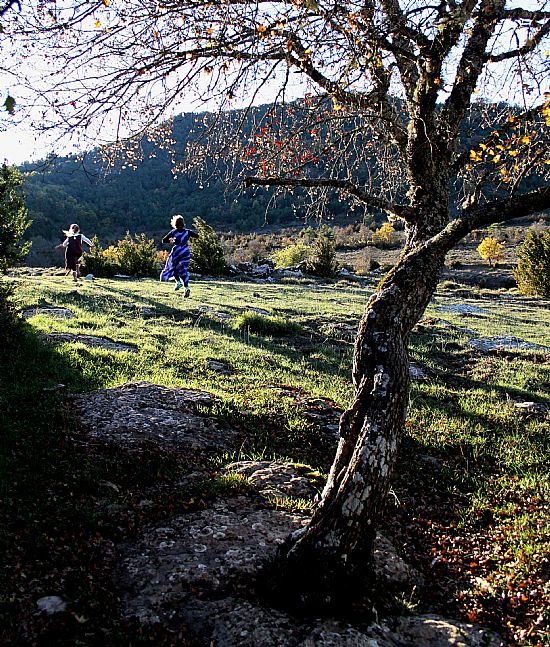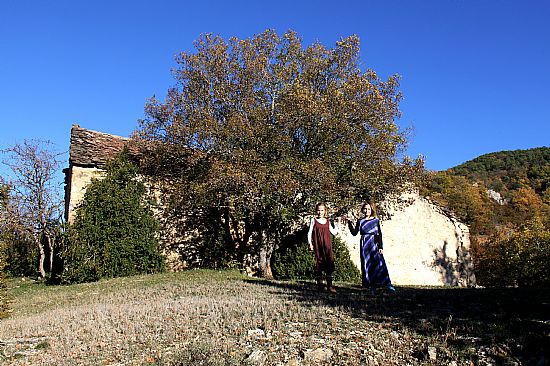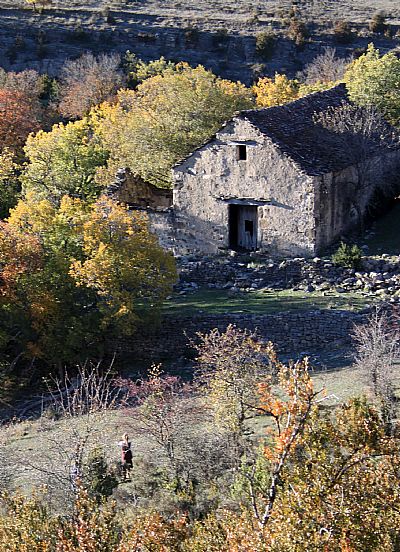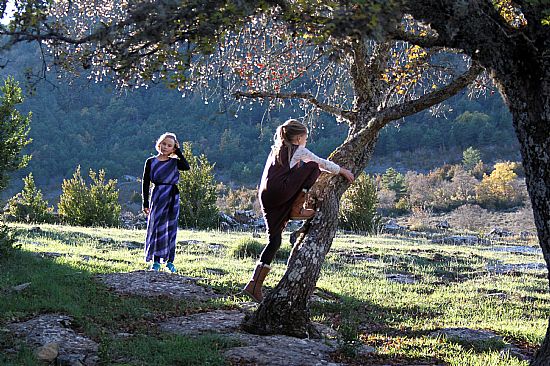Ansó, 13 November
by Isabel Isherwood - 21:22 on 13 November 2016
Yesterday the girls and I dropped Jake off in Huesca to catch a bus to Barcelona – and thence to Cameroon for a fortnight. We are quite used to him heading for Africa these days – but this is the first time he has gone since we moved to Spain. The girls were quite miserable seeing him off, and were cranky and quarrelsome for the rest of the day.
So today, to cheer ourselves up, we had an adventure. Everyone was tired so we wanted quite a short and easy adventure….. There is a Roman bridge marked on the map, about 8 km down the Río Veral from here – and only a couple of hundred yards from the road. The hillside beyond it is forested and scattered with espelungas (caves in Ansotano, the local language) and long-abandoned bordas (barns for livestock). We decided the bridge would be a good destination to start off with. Rowan and I harboured an interest in one of the bordas, named Borda del Lobo – Wolf Barn – but Iona wasn’t keen on a long walk so it didn’t seem likely we’d get that far. Because the bridge was Roman, the girls decided to dress as Romans, so we headed out in full-length dresses (well, with the exception of the chauffeur) and palas, which I am reliably informed by my ancient Rome expert are scarf/shawl-type things (Iona has read all the Caroline Lawrence Roman Mysteries books and now can tell me everything I ever wanted to know about the Romans). We decided that we would gloss over the footwear issue as it didn’t seem quite the right temperature for sandals…..

The bridge was a beautiful arch across a narrow stretch of gorge, patched up in recent years and still passable. The path to Borda del Lobo went straight up the hill in a not-entirely-attractive kind of way, but there was another very appealing narrow path skirting along a rocky ledge edged with box bushes and heading away downstream. We decided to explore. The path followed the river through a mixed forest of oak and field maple with an understorey of box and juniper. We crossed a shallow clear stream and climbed up through the woods to emerge in a beautiful meadow on a plateau above the river, now in a canyon below us. A rustling in the bushes and a dark furry thing dashed away from us down the slope – not a great view, but almost certainly our first stone marten sighting.

It was a peaceful and lovely place, very green and fertile-looking after the recent rain: an open grassy meadow with scattered trees, rising to a low rounded summit of limestone pavement, the cracks between the slabs all filled with thyme. Low stone walls and overgrown hedges bordered small terraced fields. At the top of the rise, hidden behind box and field maple, was a crumbling barn, its arched doorway framing the view down the magnificent Biniés gorge. Bathed in golden afternoon sunlight, and with the still-bright autumn leaves catching the light, it seemed almost to glow.

The girls ran off to explore, and I soon heard them calling me through the trees. Up the slope behind the meadow were more small neat fields, and an old house with lime-mortared walls and a collapsing roof of stone slabs. Peering through the empty windows we could see lovely old wooden shelves and the remains of a staircase.

We watched the sun dipping towards the horizon – a full 50 minutes after our house in Ansó loses the sun at this time of year - then made our way back through the shadowy woods to the bridge.

Add your comment